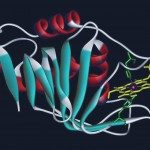Lien vers Pubmed [PMID] – 1777582
Biopolymers 1991 Oct;31(11):1309-23
The 400-MHz 1H- and 162-MHz 31P-nmr have been used to study complexes constituted by (a) the d(TpTpCpGpCpGpApA)2 or the d(CpGpCpG)2 self-complementary oligonucleotides and (b) two bifunctional 7H-pyrido [4,3-c] carbazole dimer drugs, the antitumoral ditercalinium (NSC 366241), a dimer with a rigid bis-piperidine linking chain and its pharmacologically inactive analogue, a dimer with a flexible spermine-like linking chain. Nearly all proton and phosphorus signals have been assigned by two-dimensional (2D) nmr (correlated spectroscopy, homonuclear Hartmann-Hahn, nuclear Overhauser enhancement spectroscopy, 2D 31P (1H) heteronuclear correlated spectroscopy and 31P-31P chemical exchange experiments). Both drugs bis-intercalate into the two CpG sites. The complexes show small differences in the position of the 7H-pyrido [4,3-c] carbazole ring into the intercalation site and possibly in the ribose-phosphate backbone deformation. However, the inactive analogue exhibits a longer residence lifetime in octanucleotide than the ditercalinium does. All these results are discussed in terms of differences in dimer activities.

